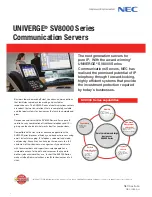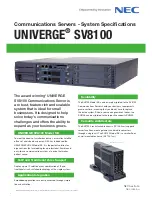
Chapter 7. Software support
297
The default in z/VM is multithreading disabled by default. There is no dynamic switching of the
SMTmode. It can be enabled or disabled only by setting the
MULTITHREADING
statement in the
configuration file. After the statement is set, you must run an IPL of the partition to enable or
disable SMT.
z/VM supports up to 32 multithreaded cores (64 threads) for IFLs, and each thread is treated
as an independent processor. z/VM dispatches virtual IFLs on the IFL logical processor so
that the same or different guests can share a core. There is a single dispatch vector per core,
and z/VM attempts to place virtual sibling IFLs on the same dispatch vector to maximize
cache reuses. The guests have no awareness of SMT, and they cannot use it.
z/VM SMT exploitation does not include guest support for multithreading. The value of this
support for guests is that the first-level z/VM hosts under the guests can achieve higher
throughput from the multi-threaded IFL cores.
IBM is working with its Linux distribution partners to support SMT. KVM for IBM z Systems
SMT support is planned for 1Q2016.
An operating system that uses SMT controls each core and is responsible for maximizing
their throughput and meeting workload goals with the smallest number of cores. In z/OS,
HiperDispatch cache optimization should be considered when you must choose the two
threads to be dispatched in the same processor. HiperDispatch attempts to dispatch guest
virtual CPU on the same logical processor on which they have run previously. PR/SM
attempts to dispatch a vertical low logical processor in the same physical processor. If that is
not possible, PR/SM attempt to dispatch in the same node, or if that is not possible, in the
same CPC drawer where it was dispatched before to maximize cache reuse.
From the point of view of an application, SMT is transparent and no changes are required in
the application for it to run in an SMT environment, as shown in Figure 7-2.
Figure 7-2 Simultaneous Multithreading
7.10 Single-instruction multiple-data
z13s is equipped with new set of instructions to improve the performance of complex
mathematical models and analytic workloads through vector processing and new complex
instructions, which can process a great deal of data with only a single instruction.
This new set of instructions, which is known as SIMD, enables more consolidation of analytic
workloads and business transactions on z Systems.
PR/SM Hypervisor
MT Aware
MT Ignorant
z/OS
z/VM
Summary of Contents for z13s
Page 2: ......
Page 3: ...International Technical Support Organization IBM z13s Technical Guide June 2016 SG24 8294 00 ...
Page 24: ...THIS PAGE INTENTIONALLY LEFT BLANK ...
Page 164: ...136 IBM z13s Technical Guide ...
Page 226: ...198 IBM z13s Technical Guide ...
Page 256: ...228 IBM z13s Technical Guide ...
Page 414: ...386 IBM z13s Technical Guide ...
Page 464: ...436 IBM z13s Technical Guide ...
Page 476: ...448 IBM z13s Technical Guide ...
Page 498: ...470 IBM z13s Technical Guide ...
Page 502: ...474 IBM z13s Technical Guide ...
Page 568: ...540 IBM z13s Technical Guide ...
Page 578: ...550 IBM z13s Technical Guide ...
Page 584: ...556 IBM z13s Technical Guide ...
Page 585: ...ISBN 0738441678 SG24 8294 00 1 0 spine 0 875 1 498 460 788 pages IBM z13s Technical Guide ...
Page 586: ......
Page 587: ......
Page 588: ...ibm com redbooks Printed in U S A Back cover ISBN 0738441678 SG24 8294 00 ...
















































